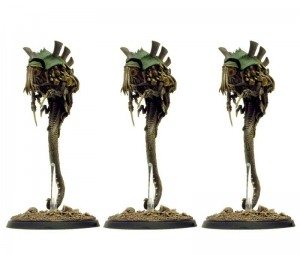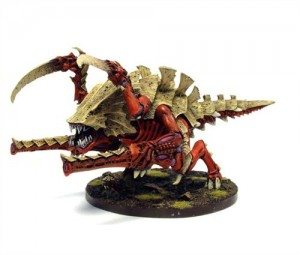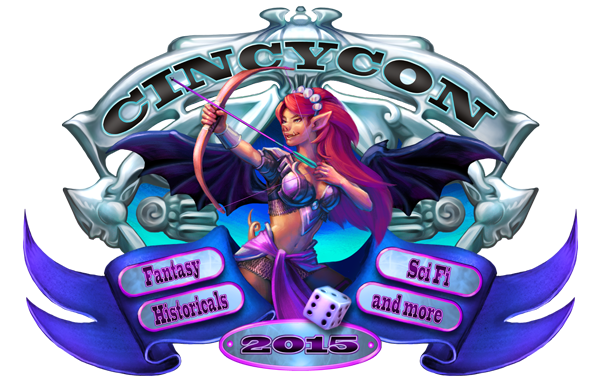by Bigpig
Hey everyone. Bigpig here to wax philosophicatactically about what I feel is the most effective Tyranid playstyle available to the current codex; Something I like to call, “The Trapdoor Spider.”
I coined that term (trademark pending, Paypal me when you use it) on the Tyranid boards while discussing my experiences at last year’s Las Vegas Open, hashing out what worked and what didn’t. I use the term “playstyle” instead of build because what I feel makes the Trapdoor Spider work is the way you approach the game and use those handful of Tyranid units that are spectacular. Certainly, this playstyle takes advantage of some of the usual suspects in the Tyranid codex, but I have had success using this approach with a variety of codex bench warmers supporting those key units. After all, when polishing a turd, it pays to start out with the best turds available.
Turd? Is this going to be just another whine fest by a disgruntled Genestealer lover??? Ok, so I’m not STILL hanging my head low and kicking rocks about how the Tyranid codex was a disappointment and “isn’t competitive.” To be sure, it doesn’t have the competitive breadth of something like Space Marines or Eldar, but it does have two or three units forming the core–courtesy of Forge World updates and some formations–which, in the hands of a patient general, can solidly win you games when used correctly. I’ve been sticking with my bugs since the book dropped, trying to find just the right combination and I may have it in the Trapdoor Spider.
Why Trapdoor Spider? Well, trapdoor spiders are ambush predators. That means they wait for the prey to come to them, jump out of their hiding place, sucker punch them, and continue to beat the crap out of the prey before they realize what hit them. Not very gentlemanly, but effective. This is in contrast to hunting spiders which go out and look for their prey and are exposed in the process to other predators. It’s all about lying in wait. The typical 40k army, is the hunting spider. Mobile, fast, and oftentimes able to redeploy anywhere on the board in a single turn, they go ferret out the prey and kill them. The advent of Maelstrom objectives has made mobility even more telling. Successful armies like Eldar, Marines, Necron Air, or pretty much any mech’d up force meet this description. Lacking the ability to move anything more than 12″ a turn and still claim an objective, Tyranids cannot be the hunter. They must instead become the ambush predator and wait safely in their lair, making their prey come to them, until it is time to pounce and deliver the overwhelming counter-stroke.

To make this work, the Trapdoor Spider Tyranid relies on what is really the only synergistic rule in the entire codex, “Spore Cloud.” This is, of course the ability on Venomthropes and Malanthropes to give shrouding to all Tyranid units within 6″. In your typical ruin or rubble terrain, this means a 2+ cover save for any unit in range. Even twisted copse (the fancy GW trademark name for whatever trees or crystal forest you choose to throw on the board) will grant a 3+, 2+ during night fight. Yes, yes, we all know about ‘thropes. Nothing new here. The difference with the Trapdoor Spider, however, is patience. The Spider plays differently than most armies because it doesn’t leave its lair until it has to. I see typical Tyranids use ‘thropes to charge their models across the board as early as turn 1 or 2. The Trapdoor Spider instead says, “Be patient and stay in cover till turn 3 or later.”
Much of the current meta is characterized by the unavoidable alpha strike. Drop marines, Eldar or Tempestus deepstrikers, any flyer heavy army, 3×3 deepstriking Obliterators, Grey Knight formations, White Scar bikes, Rhino rush, and the soon to be new hotness of Web Way Portal Dark Eldar all want to hop on the board or close with you and deliver a knock-out blow. With its 2+ cover coupled with high toughness models, multiwound models, or ablative fodder models, the Trapdoor Spider can weather that storm and punch back hard on the alpha strikers, killing the hunters, before venturing out in force to take objectives later in the game from backfield campers. This can be extremely effective. At the Brawl in the Fall, I only lost five units in the ENTIRE five game tournament (not counting sacrificial ripper swarms). Remember, the key is not leaving your 2+ lair until you have dealt with the enemy’s hunter units. ‘Nids that charge forward prematurely die.
But will they enemy come to you? Yes, they will. It is in their DNA and army design. Many of these alpha strike lists must move forward, drop in, or deepstrike on a timetable dictated by the game’s reserve rules. The Trapdoor Spider takes advantage of this by waiting the enemy out. At Brawl in the Fall I faced Rawdogger’s Grey Knight list. He had teleporting Dreadknights, reserved flyers, and a Centurion Star with Draigogate and librarians. Being a skilled player, Rawdogger KNEW what I was doing. He tried to hide out turn 1 hoping I would come to him, but I stayed in cover and sniped with hard hitting long range fire. On turn 2 as his reserves started coming in he had to make his move or lose any advantage so he teleported forward and fired into the 2+ cover killing nothing. In return I unboxed his biggest threats, retaining cover against a turn 3 counterstrike from what was left and mopped up the rest of the game.
When to leave your lair? I usually wait till turn 3 or 4 to rush forth and grab objectives for the primary mission. By then, most of the enemy reserves will be on the board and you will have dealt with their heavy lifters, often having gained first blood and not having lost a unit at all by this point. This is where another key component comes in , objective placement. Any good player can tell you that the game can be won or lost before a single model is placed on the board depending on mission and where objectives go. Place your objectives knowing you won’t make your move till late game. Place them where you can get to them. If something must go in your opponents DZ, put it in a far corner where your deepstrikers can get it (more on this later). While I could spend an entire article talking about objective placement, the simple rule is; Ask yourself WHY you are placing an objective in a specific location. How does it fit into your plan and interact with what your opponent brings to the table? If you don’t have an answer, then you need to think about it more. Devise your plan before your models hit the table.
Maelstrom missions can be harder and you may well likely start behind. Don’t panic and break cover too soon. The modified charts under BAO format help with a healthy smattering of “kill an enemy unit” and “have 3 units in your deployment zone.” Often times one of the objectives will be right in the middle of your camp anyways. Focus on denying the enemy points in the first few turns. You will score in the last few. Be patient. Plan. Be the ambush predator.
The key units and how to use them
Malanthropes: The lynchpin unit. Much has been said about these across the community already. Cheaper than two Venomthropes and far more survivable, all the while providing synapse; What is not to love? At only 85 points they will save you several hundred to a thousand points in casualties. Take two if you like, though one typically will suffice. If they survive until near the end of the enemy’s turn three shooting phase, they have done their job. Deploy them centered in your cover and preferably out of LoS of the enemy’s backfield units. I tend to place them directly on top of the objective I placed in my own DZ. Don’t have access to Malanthropes or FW is not allowed? Venoms can work as well. They are easier to hide from LoS, but suffer from being ID’d to Str8 on an unlucky 1. Consider taking 2 or deploy them in an Imperial Bunker or Bastion for increased safety and radius of effect. Malanthropes are a game changer with their survivability but Venoms can be a less efficient back up.
Flyrants: Arguably the best flyer in the game, Dakkaflyrants (double twin link brain leech worms) bring devastating firepower, mobility, downrange synapse, psyker powers, and survivability to the table. They blast infantry, light vehicles, and knights. They kill 2+ saves with volume of fire. Many people complain that they die. They aren’t using them right. Keep them in the spore cloud until it is time to strike. If they start in the rear of your cover blob they can Swoop 12″ forward and snipe into the enemy lines and still be in the spore cloud giving them a 2+ jink option in open ground. This is especially important vs enemy flyers coming in from reserves. Remember that they can also claim the “area terrain” cover save for ruins/rubble/forest for having a toe in, also giving them a 2+ without having to jink. Facing BS4, a flyrant with 2+ cover will take 216 bolter shots, or 45 melta shots to kill outright. That is pretty tough. (I’m a cop, not a mathematician so prove me off by a few percent if you must, but the point is they don’t fall out of the sky unless you stick them out there to get beat down). Take at least two.

Barbed Hierodule: Oh what a difference Forge World makes. The Hierodule is not key, but she brings so much to the Trapdoor Spider. The Hierodule gives you what you are lacking otherwise; Long range punch and late game speed. The ability to put out 12 Str 10 shots between 2 targets a turn puts pressure on opponents who might otherwise be reluctant to step into your parlor. Toughness 8 with a 2+ cover and 5+ FNP means they cannot sit back and snipe your Hierodule who sits in the spore cloud with a toe in cover saying, “Come at me bro, see what happens.” Str 10 gives you an answer to AV 13/14, instagibs Thunderwolves and T5 units, and long range/high volume AP3 lets you wipe power armored campers off objectives across the board. Turn 3, 4, or later when you make your move, the 12″ move and ability to double run if needed can put you anywhere on the board fast to Thunderblitz or take downrange objectives. Hierodules can stomp invisible units and flip land raiders with ease. They were worth the price tag.
Rippers: The lowly Ripper is the quiet workhorse of the Trapdoor Spider . By deepstriking they allow you to stay competitive on the secondary/maelstrom objectives. Many of those objectives will center around holding a far objective marker (placed in a safe corner if you were crafty) or being in the enemy deployment zone. Expect them to be dead by the end of the game, but in the meantime they will keep you competing for secondary. If they survive to grab a primary objective, all the better.
Beyond these units, the Trapdoor Spider can employ a variety of units and options in the secondary role;
Biovores: Long range sniping, devastaing vs xenos races with low toughness and 4+ saves. These guys put more pressure on while safe out of LoS in the 2+ cover. They force the enemy to come to your lair.
Ranged MC firepower: Exocrines, Tyrannofex, and DakkaCarnifex are all valid options. The provide mid range firepower to stand in the cloud and threaten the enemy or charge and smash deepstriking units in power armor, all on a survivable platform. All work well depending on your preference.
Swarm: Hordes of Termagaunts, Gargoyles, and Hormagaunts can give you a bubble wrap in the backfield and the ability to flood midfield late game. This is especially valuable if you know you will face lots of Imperial Knight armies, but it is very susceptible to flamers and T-Fire cannons. It also gives you less firepower.
Shrikes/Warriors/Raveners: Not my first choice, but these can give you an effective counterstroke melee unit with the ability to move quickly late game to midfield. They tend to be more susceptible to ranged artillery and, of course Str8 fire, than MCs though. Shrikes with poison Boneswords scare the crap out of Wraithknights, but then again so do Carnifexen.
Living Artillery: My favorite. This gem gives you the benefits of many of the above options in a more accurate package.
Here is a typical Trapdoor Spider list at 1750pts;
Combined Arms
Tyrant; Wings, Double Brainleech worms, Electroshock Grubs, Warlord
Tyrant; Wings, Double Brainleech worms
Malanthrope
2×3 Deepstriking Ripper Swarms
Carnifex; Double Brainleech Worms
Barbed Hierodule
Living Artillery Formation
Exocrine
3 Biovore
3 Warriors (1 Barbed Strangler)
Weaknesses
The current meta with Superheavies, formations, wonky psyker powers, and allies really lends itself to Rock/Paper/Scissor matchups. The Trapdoor Spider manages to avoid most auto-lose match-ups, but there are still some tough nuts out there. So what gives the Trapdoor Spider problems? Obviously anything that won’t come to play with you. Fortunately, those lists aren’t as common in the current meta. There are a couple other stumbling blocks to be aware of as well. Here are some of the challenges and ways to deal with it;
Imperial Knights: A single IK is easy. Flyrants in the flanks and Hierodule in the face will kill one a turn with ease. A formation of three can be much tougher and a Knight will waste your Hierodule in combat. To counter triple knight, hope to go second and use a refused flank if possible. Fall back and waste the closest knight as soon as possible. Falling back will buy you an extra turn before the assault, hopefully buying enough time to cripple the second knight. Try to get them to charge you in cover or put up bubble wrap to buy extra time.
The Scouring/Hammer and Anvil: These two mission and deployment options really do not do the Trapdoor Spider any favors. A high number of objectives scattered around and lots of real estate can make it tough to score. This is the only time you may need to break cover sooner. It really depends on your opponent. The combination of these two, along with a boots heavy drop list pushed me to third at the recent Brawl. I just didn’t have enough to take all the objectives at the end of game. It can be a challenge.
Ignores Cover: Fortunately, most ignore cover weapons tend to be low strength (with the exception of Serpent Shield). These don’t challenge a MC list in cover as you still have a 3+ save. If you play vs Serpents, deploy more defensively and try to snipe them out with Flyrants and Hierodule. Against a Perfect Timing list, you will have more problems, but you can try to assassinate the unit with the psyker early on.
So that is the Trapdoor Spider in a nutshell. Remember, the key is in patience and waiting for the moment to strike. Most Tyranids, even the best ones out there, make their move too soon to truly be playing as the Spider even when using all the components. The Trapdoor Spider is a defensive concept rather than offensive. The army really plays to the current alpha strike meta. What are your thoughts? Have you faced it? How would your army deal with it?
- See more at: http://www.frontlinegaming.org/2014/10/














![th[5]](https://www.frontlinegaming.org/wp-content/uploads/2014/10/th5.jpg)



